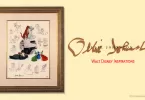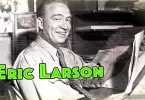After his stint as an ambulance driver in France in WWI, Walt Disney returned to his former childhood town (his second childhood town, after Marceline, Missouri) in Kansas City, Missouri. While there, he obtained a job as an apprentice artist for the Pesman-Rubin Commercial Art Studio. At the studio, Walt drew commercial drawings for ads, catalogs, theater programs, and other things of that nature. He also became good friends with a fellow artist there named Ub Iwerks.
After a few months of working at Pesman-Rubin, the company’s revenue began to decline, and Walt and Ub were laid off. They decided to start their own business and called it Iwerks-Disney Commercial Artists. They didn’t attract many customers, so they decided that Walt would go to temporarily work at the Kansas City Film Ad Company, which was managed by A.V. Cauger. Ub was not able to manage his and Walt’s business alone and soon joined Walt at his new job. The Kansas City Film Ad Company made animated commercials using the cutout animation technique. It was at this job that Walt first became interested in animation.
While Walt still preferred still cartoons such as the ones found in the newspapers, he began learning animation, buying himself a camera and borrowing a book on animation. With these two tools, Walt began experimenting with animation at home. His experiments lead him to believe that the cel animation technique was more promising as a revenue-producing business than the cutout method. He tried to convince A.V. Cauger to try cel animation at the company, but A.V. was not interested.
Wanting to try cel animation as a business venture, Walt opened another new business of his own, this time with a friend from the Kansas City Film Ad Company named Fred Harman. The new business was called Newman’s Laugh-O-Grams. They called it this because their first and biggest client was the local Newman Theater. Walt and Fred produced short cartoons using the cel method for the theater and other local businesses. Because Walt studied Paul Terry’s book of Aesop’s Fables when learning cel animation, the first six cartoons Newman’s Laugh-O’Grams produced were modernized versions of classic fairy tales.
The new company was successful enough that Walt and Fred established the Laugh-O-Gram Studio the next year, in 1921. They hired more animators to work for them, including Hugh Harman (Fred’s brother, Rudolph Ising, and Walt’s old friend and business partner Ub Iwerks. The company did well, but not well enough to keep the fledgling company solvent. To try to bring in more revenue, Walt made a short film based on the book Alice’s Adventures in Wonderland and called it Alice’s Wonderland. The film was a twelve-and-a-half minute production produced on one-reel film and combined live-action acting with animation. It did well in distribution to theaters but was completed too late to save Laugh-O-Gram Studio from bankruptcy, which it entered in 1923.
After Laugh-O-Gram Studio went under, Walt moved to Hollywood, California in July of 1923. At the time, New York City was the entertainment capital of the country, but Walt was drawn to Los Angeles because his beloved older brother Roy was recovering from tuberculosis there. Walt arrived in Los Angeles with the goal of becoming a movie director — live-action films, not animation.
Not long after arriving in Los Angeles, Walt heard from a film distributor in New York named Margaret J. Winkler. Her company had previously held the rights to the Out of the Inkwell and the Felix the Cat cartoons, as was losing them, so she needed a new series of cartoons to distribute. She liked Walt’s Alice’s Wonderland film and signed him in October of 1923 to produce six comedy cartoons in the Alice universe. The deal included an option for two more cartoon series of six episodes each.
Walt formed the Disney Brothers Studio with his brother Roy as a result of this deal with Margaret Winkler. The company later became the Walt Disney Company. Disney Brothers Studio produced the agreed-upon cartoons for Margaret Winkler. He was able to convince his original Alice actress, Virginia Davis, to move with her family to Hollywood, and put her on contract with his new studio for $100 a month. In July 1924, Walt also convinced his old friend Ub Iwerks to move from Kansas City to Hollywood and work for him and Roy.
In early 1925, Walt hired Lillian Bounds as an ink artist for the Disney Brothers Studio. They fell in love and were married in July of that year, in her hometown of Lewiston, Idaho. They had their daughter Diane in December of 1933 and adopted their daughter Sharon three years later. Lillian was more interested in managing the house, raising their daughters, and supporting Walt rather than being a part of the Hollywood social scene, and both Walt and Lillian were careful to not allow their daughters to be photographed as Walt became more famous, because of the kidnapping of the Lindbergh baby. They were careful to keep their family protected and happy.
In 1926, Margaret Winker’s husband, Charles Mintz, had taken over her job as a film distributor, and the Alice series Margaret had commissioned from Walt ran until July 1927. At that time, Walt was growing bored with the mixed live-action and animation format and wanted to move to do just animation. Because Charles Mintz wanted a new cartoon to distribute through Universal Pictures, Walt and Ub Iwerks created a character called Oswald the Lucky Rabbit and gave that to Charles to distribute.
The Oswald series did well, and the next year, Walt wanted to negotiate a larger fee with Charles Mintz for producing it. Mintz, on the other hand, wanted to reduce the fee. Mintz also persuaded several artists working for Walt and Roy to work for him instead. At the same time, Walt discovered that Universal owned the intellectual property rights to his and Ub’s Oswald creation. Mintz threatened to start his own animation studio and produce the Oswald cartoons himself if Walt didn’t agree to the reduced payments. Walt refused, and subsequently lost all of his artists and animators to Mintz, except for Ub Iwekrs.
Walt needed a cartoon character to replace Oswald and keep the Disney studio on top in Hollywood. To do that, Walt and Iwerks developed a cartoon character that is still known, beloved, and instantly recognized around the world today — Micky Mouse.







